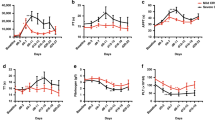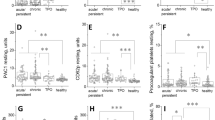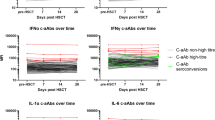Abstract
Background
Hemophilia A (HA) therapy requires intravenous replacement infusions of factor (F) VIII concentrate. Inhibitors are high-affinity immunoglobulin G that are directed against FVIII and thereby render replacement therapy ineffective. This complication has significant prognostic implications. We aimed to examine the immune system involvement in inhibitor formation specifically T-cell excision circles (TRECs) and B-cell excision circles (KRECs), markers of new T and B cells, respectively, and examine them as surrogate markers for inhibitor formation.
Methods
Blood samples were collected from 35 children with severe HA. Children were divided into two groups: with FVIII inhibitors and without FVIII inhibitors. TRECs and KRECs were measured in peripheral blood.
Results
A total of 11 patients with inhibitors and 24 without were evaluated. Children with inhibitors had higher levels of TRECs however not statistically significant (p = 0.085). CjKREC levels were higher in the inhibitor patients (p = 0.003). Moreover, the sj/cjKREC ratio was lower in the inhibitor patients (p = 0.015).
Conclusions
Our findings may add to the notion that inhibitor formation is attributed to humoral immunity due to peripheral B-cell expansion and loss of peripheral tolerance. Improved knowledge regarding the involvement of the immune system in the formation of FVIII inhibitors will enable better therapy tailoring in the era of non-replacement therapies.
Impact
-
The etiology of FVIII inhibitor formation is multifactorial, in which the immune system plays a pivotal role.
-
Our findings may add to the notion that inhibitor formation is attributed to humoral immunity due to peripheral B-cell expansion and production of antibodies against FVIII.
-
Improved knowledge regarding the involvement of the immune system in the development of FVIII inhibitors will enable the identification of patients prone to inhibitor development and better therapy tailoring in the new era of non-replacement therapies.
This is a preview of subscription content, access via your institution
Access options
Subscribe to this journal
Receive 14 print issues and online access
$259.00 per year
only $18.50 per issue
Buy this article
- Purchase on Springer Link
- Instant access to full article PDF
Prices may be subject to local taxes which are calculated during checkout




Similar content being viewed by others
Data availability
The datasets generated during and/or analyzed during the current study are available from the corresponding author upon reasonable request.
References
Blanchette, V. S. et al. Definitions in hemophilia: communication from the SSC of the ISTH. J. Thromb. Haemost. 12, 1935–1939 (2014).
Oldenburg, J. & Pavlova, A. Genetic risk factors for inhibitors to factors VIII and IX. Haemophilia 6(12 Sup), 15–22 (2006).
Hazenberg, M. D. et al. Increased cell division but not thymic dysfunction rapidly affects the T-cell receptor excision circle content of the naive T cell population in HIV-1 infection. Nat. Med. 6, 1036–1042 (2000).
Serana, F. et al. Thymic and bone marrow output in patients with common variable immunodeficiency. J. Clin. Immunol. 31, 540–549 (2011).
Levy-Mendelovich, S. et al. Quantification of specific T and B cells immunological markers in children with chronic and transient ITP. Pediatr. Blood Cancer 64, 12 (2017).
Machnes-Maayan, D. et al. Insight into normal thymic activity by assessment of peripheral blood samples. Immunol. Res. 61, 198–205 (2014).
Lev, A. et al. The kinetics of early T and B cell immune recovery after bone marrow transplantation in RAG-2-deficient SCID patients. PLoS One 7, e30494 (2012).
Somech, R. T-cell receptor excision circles in primary immunodeficiencies and other T-cell disorders. Curr. Opin. Allergy Clin. Immunol. 11, 517–524 (2011).
Hampe, C. S. B cells in autoimmune diseases. Scientifica 2012, 215308 (2012).
Amariglio, N. et al. T-cell compartment in synovial fluid of pediatric patients with JIA correlates with disease phenotype. J. Clin. Immunol. 31, 1021–1028 (2011).
Yurasov, S. et al. Defective B cell tolerance checkpoints in systemic lupus erythematosus. J. Exp. Med. 201, 703–711 (2005).
Samuels, J., Ng, Y. S., Coupillaud, C., Paget, D. & Meffre, E. Impaired early B cell tolerance in patients with rheumatoid arthritis. J. Exp. Med. 201, 1659–1667 (2005).
Lev, A. et al. Characterizing T cells in SCID patients presenting with reactive or residual T lymphocytes. Clin. Dev. Immunol. 2012, 261470 (2012).
Astermark, J. Why do inhibitors develop? Principles of and factors influencing the risk for inhibitor development in haemophilia. Haemophilia 3(12 Suppl), 52–60 (2006).
Ljung, R., Petrini, P., Lindgren, A. C., Tengborn, L. & Nilsson, I. M. Factor VIII and factor IX inhibitors in haemophiliacs. Lancet 339, 1550 (1992).
Luna-Záizar, H. et al. F8 inversions of introns 22 and 1 confer a moderate risk of inhibitors in Mexican patients with severe hemophilia A. Concordance analysis and literature review. Blood Cells Mol. Dis. 71, 45–52 (2018).
Ghosh, K. & Shetty, S. Immune response to FVIII in hemophilia A: an overview of risk factors. Clin. Rev. Allergy Immunol. 37, 58–66 (2009).
Doshi, B. S. et al. B cell-activating factor modulates the factor VIII immune response in hemophilia A. J. Clin. Invest. 131, e142906 (2021).
Peyvandi, F. et al. RandomizeD TRIAL OF FActor VIII and neutralizing antibodies in hemophilia A. N. Engl. J. Med. 374, 2054–2064 (2016).
Carcao, M., Re, W. & Ewenstein, B. The role of previously untreated patient studies in understanding the development of FVIII inhibitors. Haemophilia 22, 22–31 (2016).
White, G. C. II, Kempton, C. L., Grimsley, A., Nielsen, B. & Roberts, H. R. Cellular immune responses in hemophilia: why do inhibitors develop in some, but not all hemophiliacs? J. Thromb. Haemost. 3, 1676–1681 (2005).
Rammensee, H. G., Friede, T. & Stevanoviic, S. MHC ligands and peptide motifs: first listing. Immunogenetics 41, 178–228 (1995).
Schwaab, R. et al. Haemophilia A: mutation type determines risk of inhibitor formation. Thromb. Haemost. 74, 1402–1406 (1995).
Hay, C. R. et al. HLA class II profile: a weak determinant of factor VIII inhibitor development in severe hemophilia A. A UKHCDO Inhibitor Working Party. Thromb. Haemost. 77, 234–237 (1997).
Abdulqader, A. M. R., Mohammed, A. I. & Rachid, S. Polymorphisms in the cytotoxic T lymphocyte-associated protein-4 immune regulatory gene and their impact on inhibitor development in patients with hemophilia A. J. Int. Med. Res. 47, 4981–4992 (2019).
Chaves, D., Belisário, A., Castro, G., Santoro, M. & Rodrigues, C. Analysis of cytokine genes polymorphism as markers for inhibitor development in haemophilia A. Int J. Immunogenet 37, 79–82 (2010).
Hoyer, L. W. The incidence of factor VIII inhibitors in patients with severe hemophilia A. Adv. Exp. Med. Biol. 386, 35–45 (1995).
Pratt, K. P. & Thompson, A. R. B-cell and T-cell epitopes in anti-factor VIII immune responses. Rev. Bras. Hematol. Hemoter. 37, 80–95 (2009).
de Alencar, J. B. et al. Importance of immune response genes in hemophilia A. Rev. Bras. Hematol. Hemoter. 35, 280–286 (2013).
Thewissen, M. et al. Analyses of immunosenescent markers in patients with autoimmune disease. Clin. Immunol. 123, 209–218 (2007).
Acknowledgements
This manuscript is dedicated to honor the memory of our dear collaborator and friend, Prof. Valder Arruda.
Funding
This study was supported by a research grant from Novo Nordisk.
Author information
Authors and Affiliations
Contributions
S.L.-M., G.K., R.S., A.L., and I.B. made substantial contributions to conception and design, acquisition of data, or analysis and interpretation of data. E.A., R.D., and A.A.B. contributed to drafting the article or revising it critically for important intellectual content. All authors approved the final version of the manuscript to be published.
Corresponding author
Ethics declarations
Competing interests
S.L.-M. received a grant and research support from Pfizer and Novo Nordisk. G.K. received a grant and research support from Alnylam, Bayer, BPL, Opko Biologics, Pfizer, Shire, and honoraria for consultancy/lectures from Alnylam, Bayer, CSL, Opko Biologics, Pfizer, Takeda, and ROCHE. Other authors have no relevant conflict of interest.
Ethics approval and consent to participate
Children’s parents gave informed consent for their child’s participation in the study. The study was approved by the Ethics Committee of Sheba Medical Center.
Additional information
Publisher’s note Springer Nature remains neutral with regard to jurisdictional claims in published maps and institutional affiliations.
Rights and permissions
Springer Nature or its licensor holds exclusive rights to this article under a publishing agreement with the author(s) or other rightsholder(s); author self-archiving of the accepted manuscript version of this article is solely governed by the terms of such publishing agreement and applicable law.
About this article
Cite this article
Levy-Mendelovich, S., Lev, A., Avishai, E. et al. Can T-cell and B-cell excision circles predict development of inhibitors in pediatric hemophilia A?. Pediatr Res 93, 1546–1550 (2023). https://doi.org/10.1038/s41390-022-02268-5
Received:
Revised:
Accepted:
Published:
Issue Date:
DOI: https://doi.org/10.1038/s41390-022-02268-5



